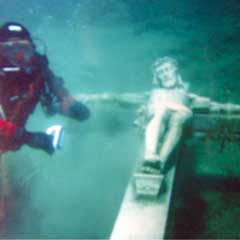Crucifix lies in the depths of Lake Michigan
By Ron Stang, Catholic Register Special PETOSKEY, Mich. - Off the picturesque tourist town of Petoskey lays a beautiful white marble crucifix. But you won’t find it in or even near any church.
PETOSKEY, Mich. - Off the picturesque tourist town of Petoskey lays a beautiful white marble crucifix. But you won’t find it in or even near any church.That’s because it is submerged offshore, in Lake Michigan, in the waters of Little Traverse Bay where it has been since 1962.
How it came to be there is an interesting story.
A 15-year-old boy named Gerald Schipinski was killed in a farm accident. In deep sorrow and wanting to commemorate their son’s death, his parents ordered a cross from Italy. But when the crucifix arrived the statue had been damaged — two arms of the Christ figure had been broken. The parents refused the shipment and the cross ended up being sold at an insurance sale.
A Detroit man who summered in northern Michigan bought the statue and repaired it. Not long after, a friend of the man lost his life in a lake mishap. So, the statue owner thought, “this would be a good time to commemorate his death by using this as a monument,” said Dennis Jessick, a sergeant with the Emmet County, Mich., Sherriff’s department.
So the owner applied for permits to place the cross at the bottom of northern Lake Michigan.
“I think close to 2,000 people were on the city dock” the day the statue was lowered into about 20 metres of water some 400 metres offshore, said Jessick, who is often described as the unofficial keeper of the cross and was there the day of its underwater burial.
It remained at the same site for 30 years, but over the years the crucifix became covered with sediment. A diving club decided to move it to a limestone rock bed closer to shore.
“And that’s where it ended up being placed out in front of Sunset Park,” Jessick said.
The crucifix is not easy to see. In summer, you can take a boat to a buoy above the monument and try to stare down to see it. Jessick said some scuba divers swim down by grasping the buoy’s chain. Scattered around the crucifix are plaques in memory of people who have died.
The best time to see the cross is in mid-winter. Each February, when sufficient ice has formed, Jessick and others cut a viewing hole. Over the top they place a canopy.
“It works really nice,” he said. “We try to get rid of any extraneous light.”
Underwater electric lights illuminate the crucifix, giving it a lime green “eerie glow,” he added.
“That marrow silt clay limestone bottom renders it back a yellow green glow. It’s very strange but very memorable and beautiful,” said Jessick.
The cross’s length is about 3.5 metres with the Christ figure almost two metres long.
“So if you were to look at it topside down, I mean hover over him and look, it would be a life-size figure,” Jessick said.
Diane Dakins of the Petoskey Area Visitors Bureau said each year in January her office “begins getting calls from folks who want to know when the viewing of the crucifix will be.”
She said the bureau doesn’t post the date until it’s confirmed — “and even then, it’s always subject to change.”
Dakins added that “locals and visitors alike are awed” by the site. On the day of the event “many people will find it quite by accident and follow the lines of guests to the viewing area. Once they’ve been here visitors generally want to come back the next year.”
(Stang is a freelance writer in Windsor, Ont.)
Please support The Catholic Register
Unlike many media companies, The Catholic Register has never charged readers for access to the news and information on our website. We want to keep our award-winning journalism as widely available as possible. But we need your help.
For more than 125 years, The Register has been a trusted source of faith-based journalism. By making even a small donation you help ensure our future as an important voice in the Catholic Church. If you support the mission of Catholic journalism, please donate today. Thank you.
DONATE